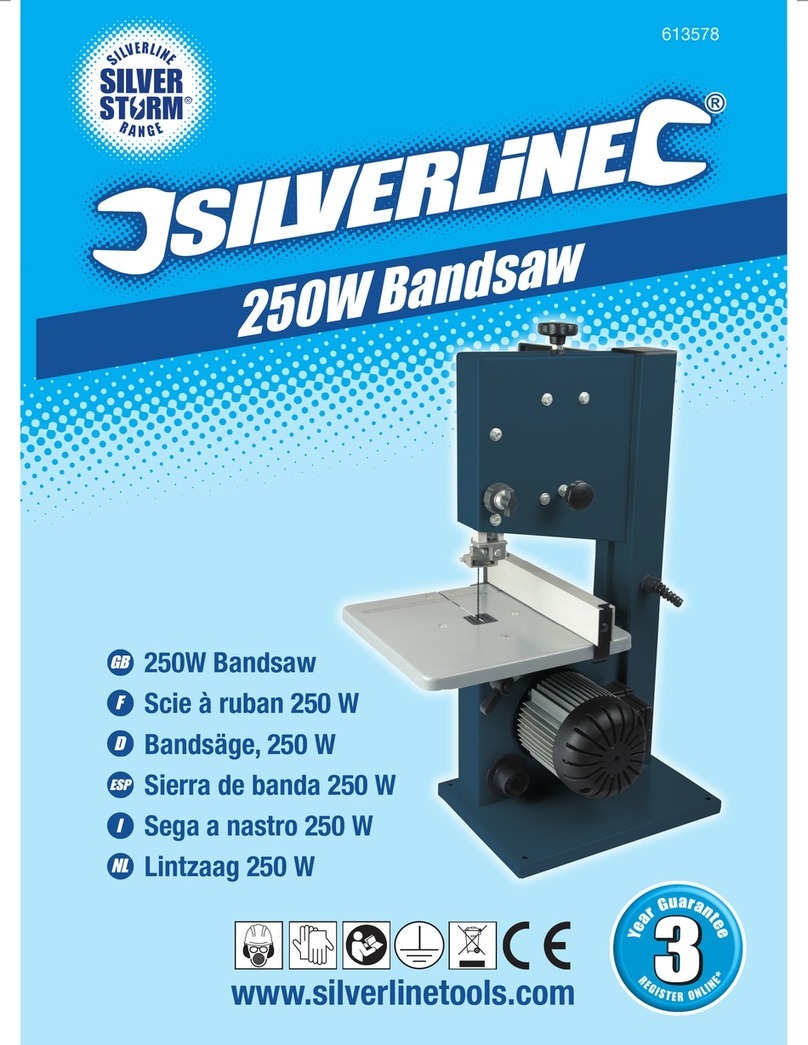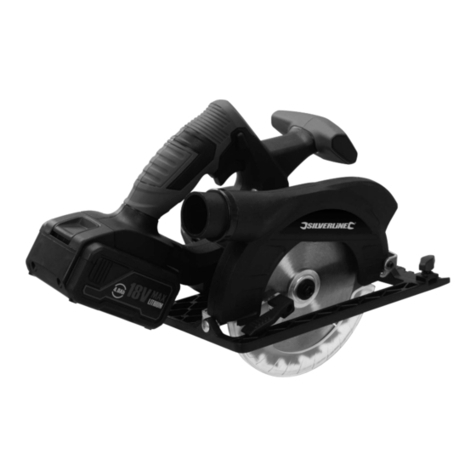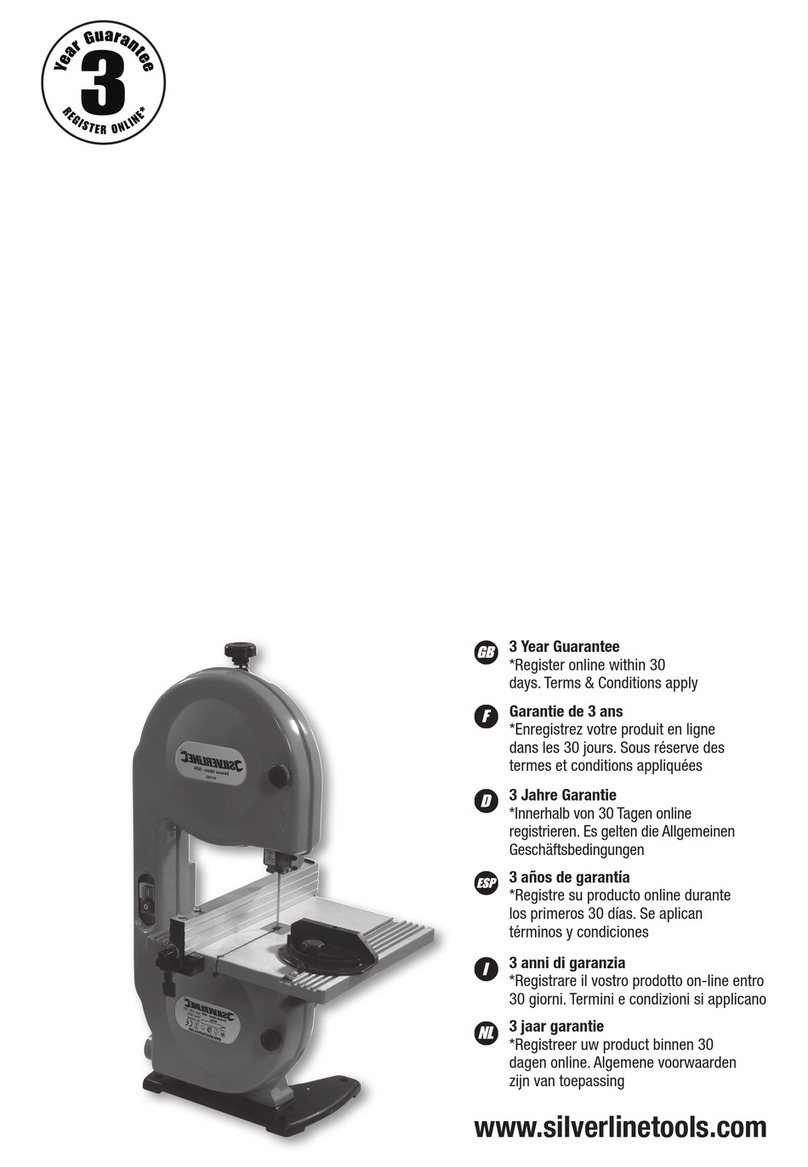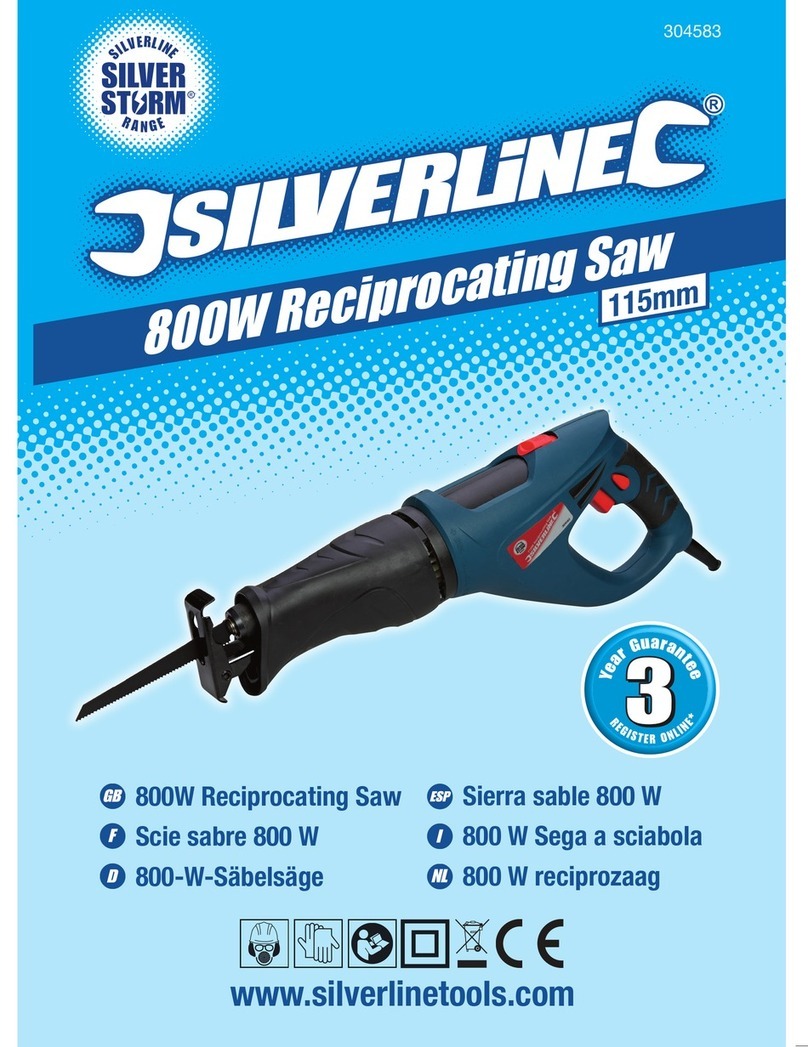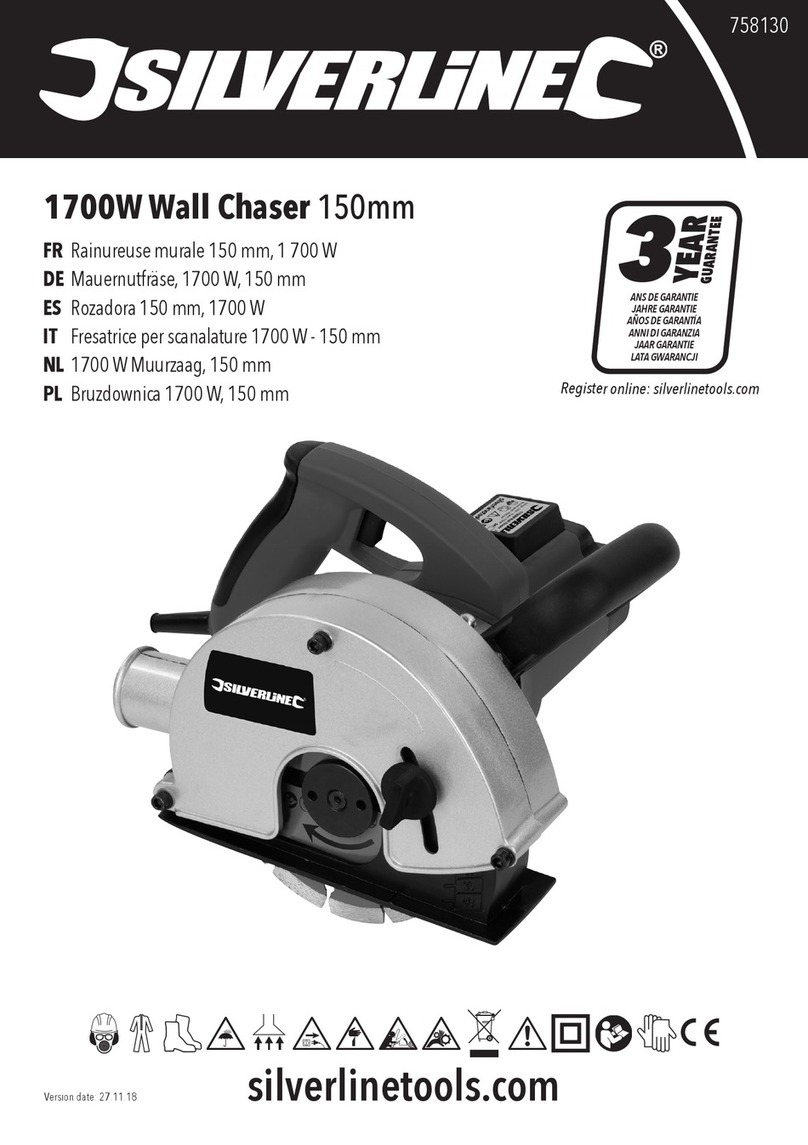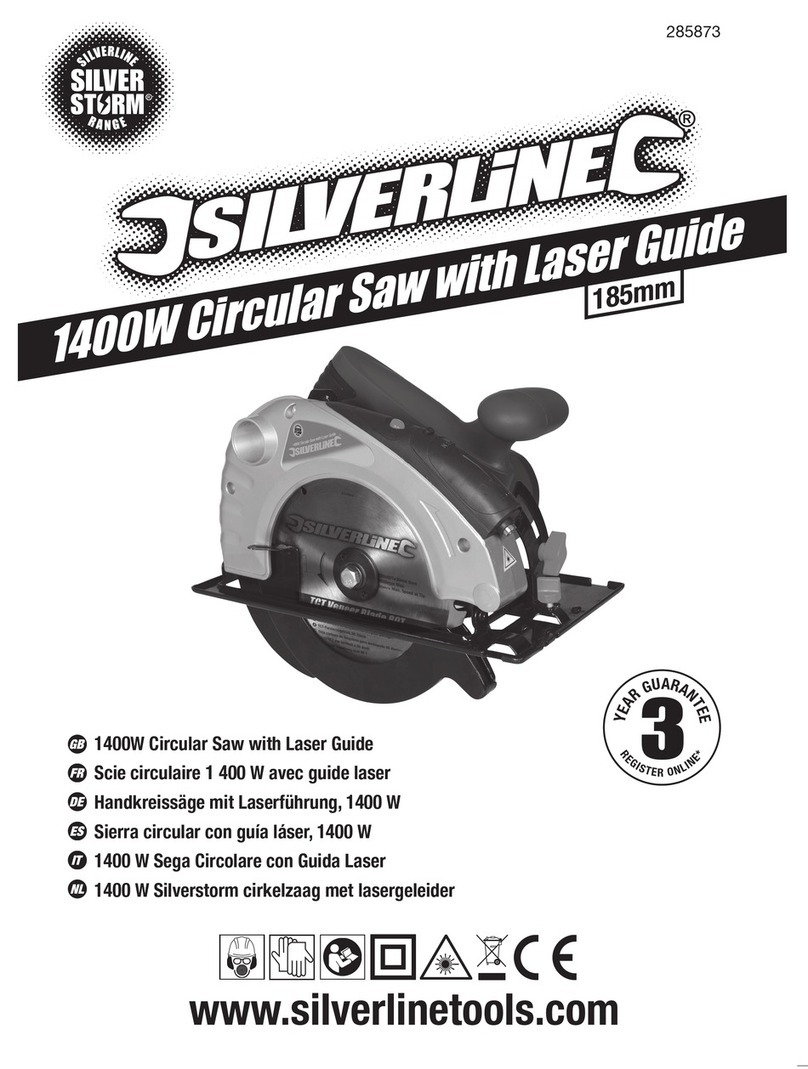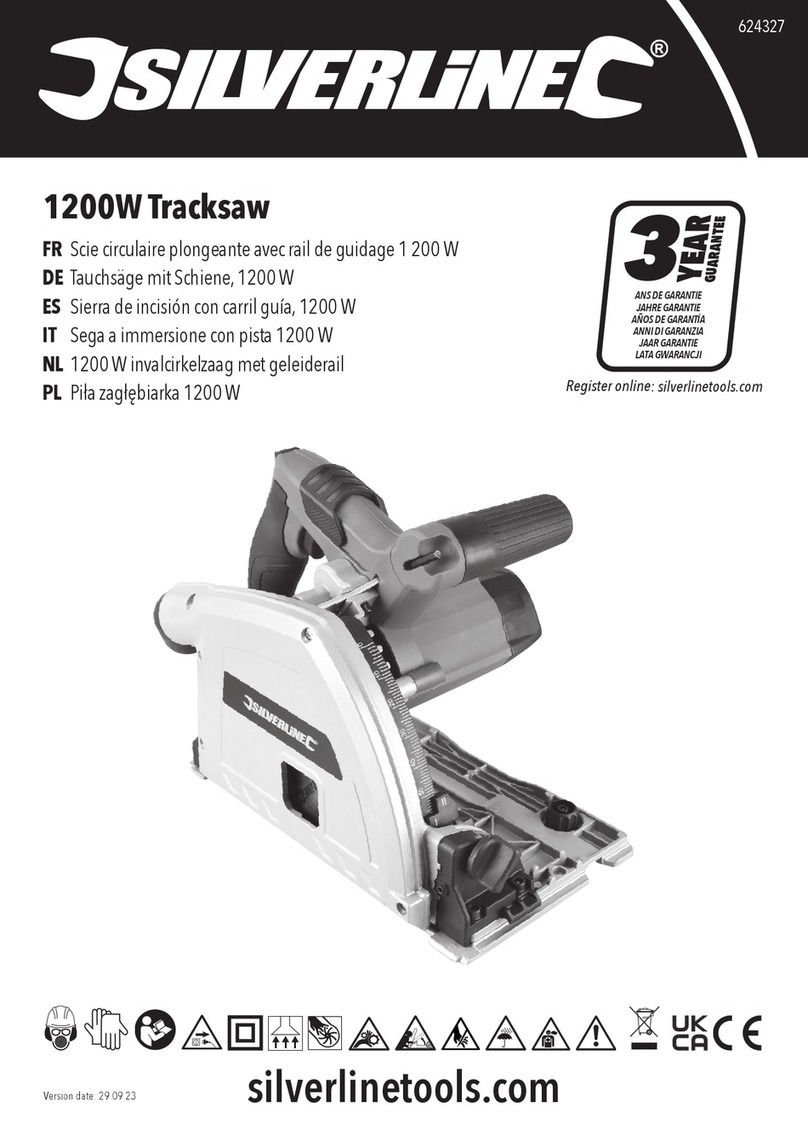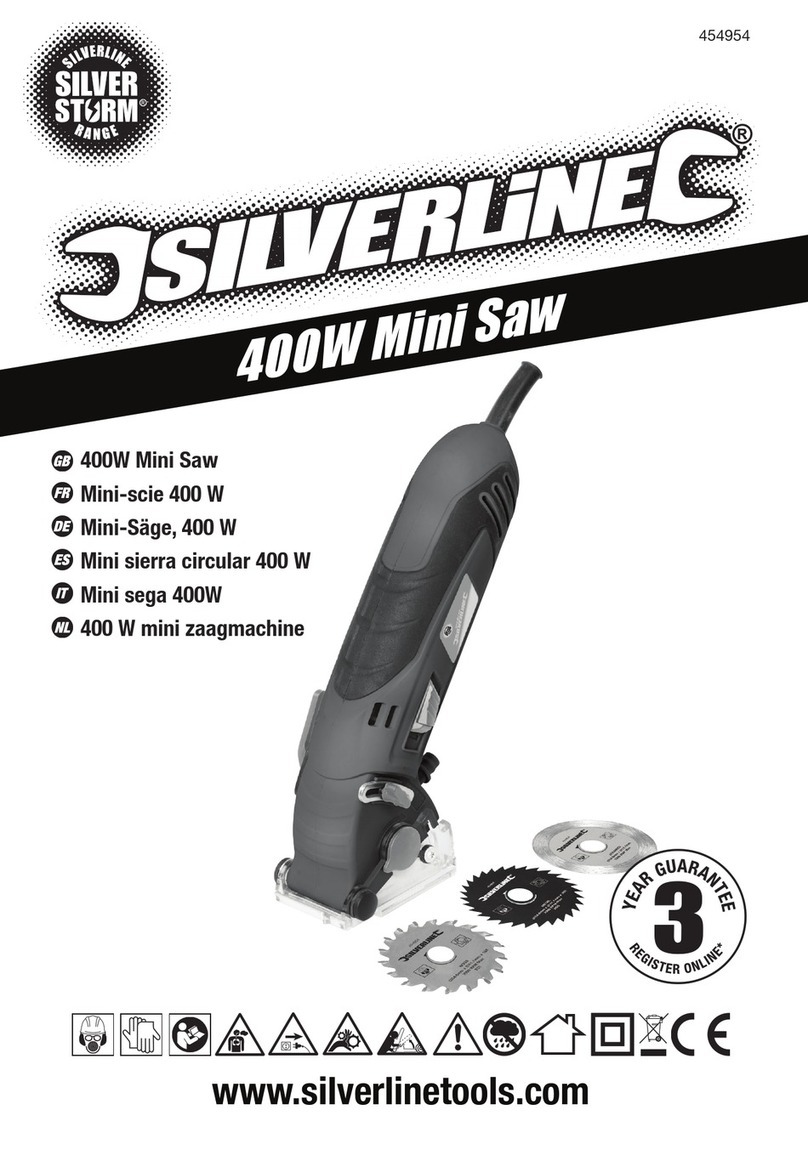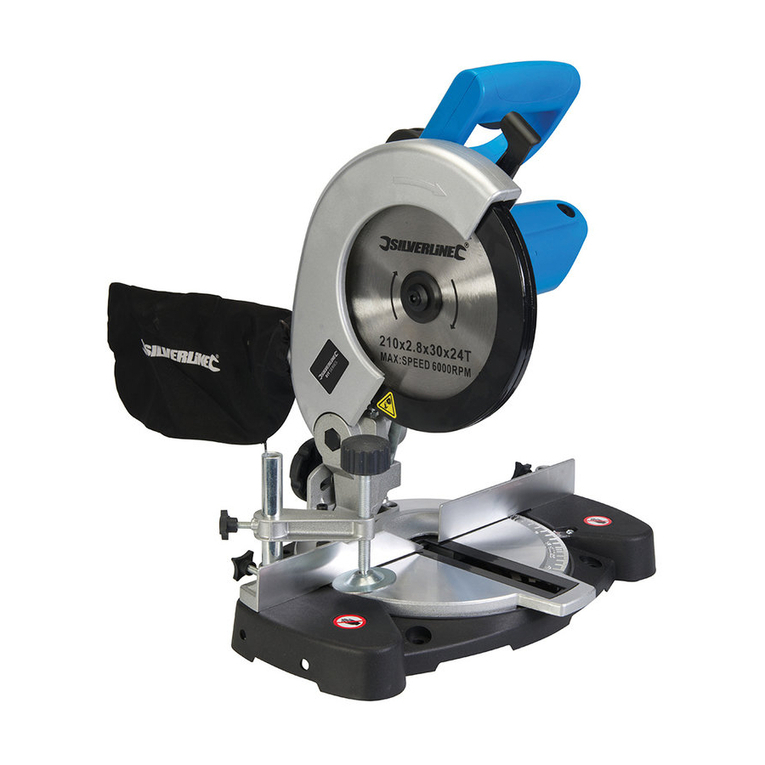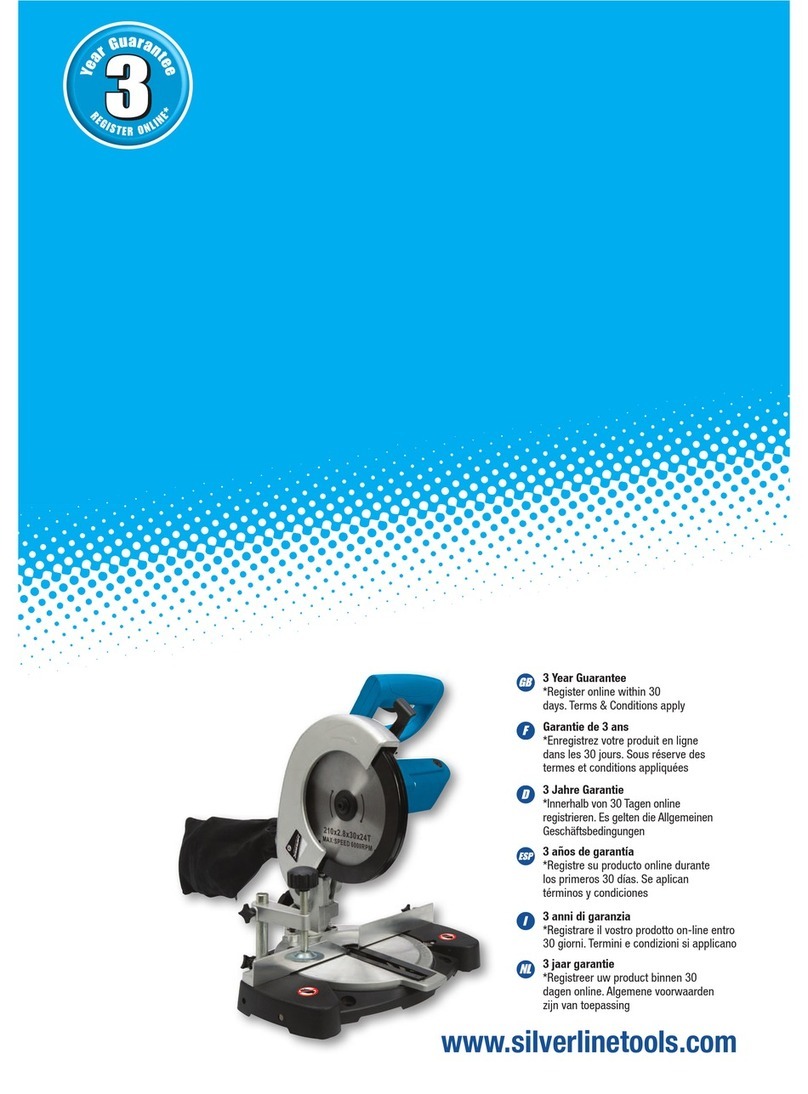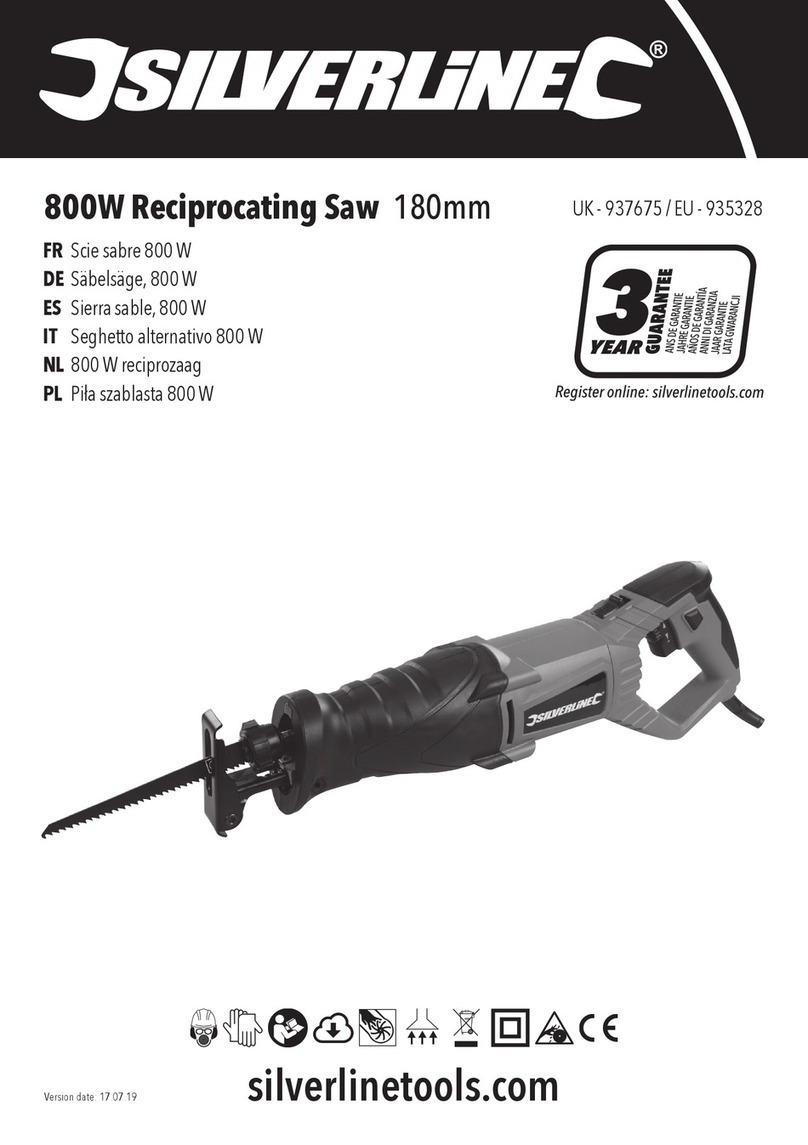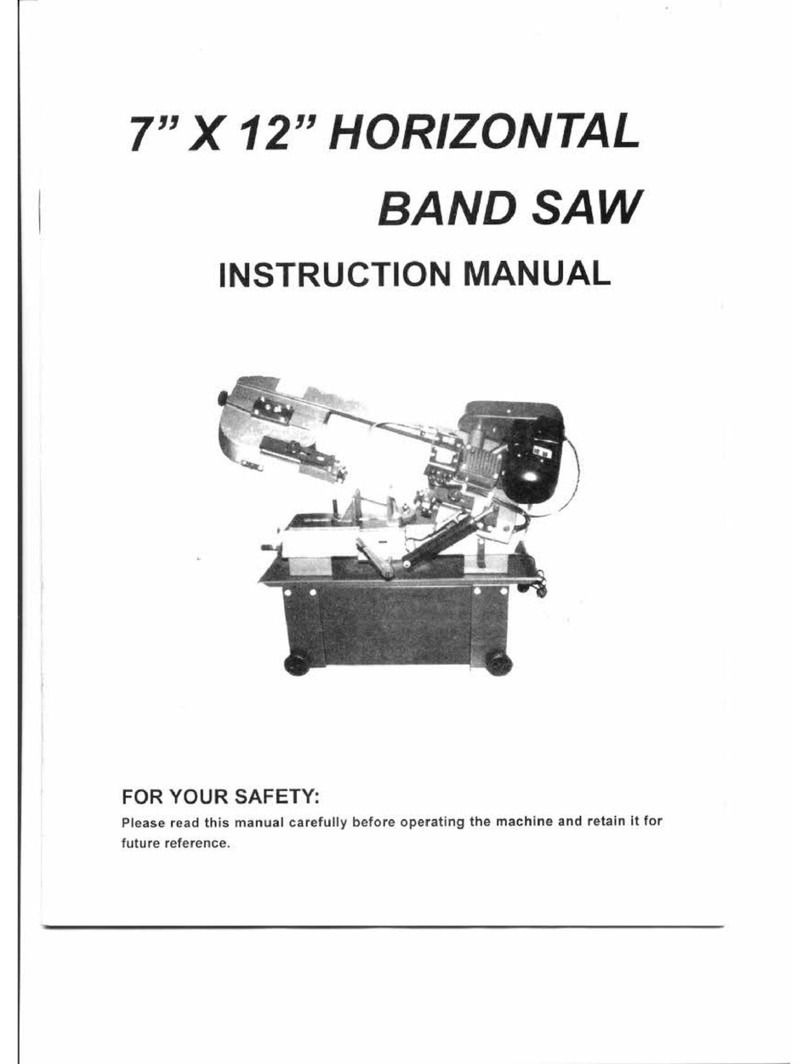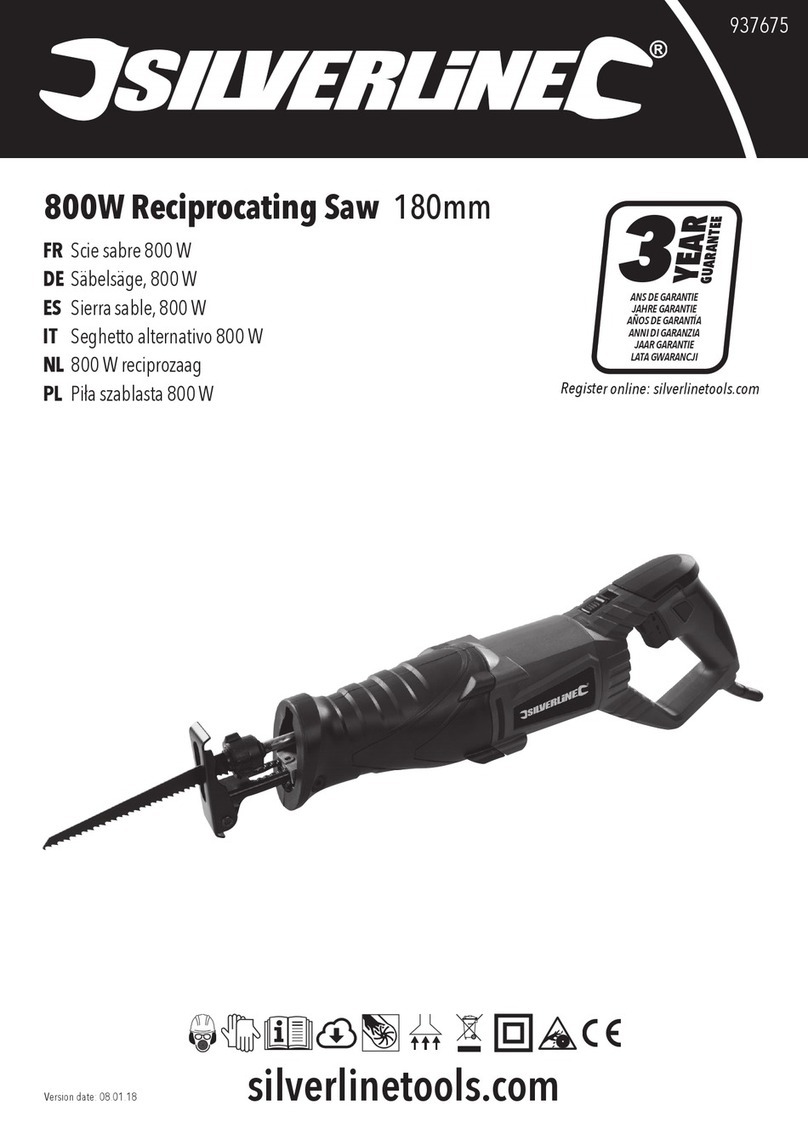
GB
10
n) Always ensure the saw blade is suitable for the material being cut and that the maximum
rpm of the blade is not exceeded by the maximum no load speed of the saw
o) When using blades with a larger bore than the mitre saw spindle ensure the correct size
bore spacer (spindle ring) is used
p) When transporting the saw,ensure its own transport handle is used (not the operating
handle) and that the saw is in the locked down position
q) Do not remove cut-off material or swap the workpiece without rst returning the saw
head to the top position with the guard closed
r) Ensure work is correctly supported. Large panels may sag under their own weight and
bind the saw blade. Supports must be placed under the panel on both sides, close to the line of
cut and near the edge of the panel
s) Ensure all supports and power cables are completely clear of the cutting path
t) Always secure the workpiece to a stable platform, ensuring body exposure is minimised,
avoiding blade binding, or loss of control
u) Do not stand in line with the saw blade of the mitre saw in use. Stand to the side to avoid
possible kickback
v) Note the direction of rotation of the motor and the blade
w) Inspect the workpiece and remove all nails and other embedded objects prior to starting
work
x) Do not apply any sideways or twisting force to the blade whilst cutting
y) If a cut does not extend to the edge of the workpiece, or if the blade binds in the cut,
allow the blade to come to a complete stop and lift the saw out of the workpiece
z) Do not attempt to free a jammed blade before rst disconnecting the machine from power
1. Beware of projected waste.In some situations, waste material may be projected at speed from
the cutting tool. It is the user’s responsibility to ensure that other people in the work area are
protected from the possibility of projected waste
2. If you are interrupted when operating the saw,complete the process and switch off before
diverting your attention
3. Check the lower guard for proper closing before each use. Do not operate the saw if the lower
guard does not move freely and close instantly.Never clamp or tie the lower guard into the open
position. If the saw is accidentally dropped, the lower guard may be bent.Raise the lower guard
with the retracting handle and make sure it moves freely and does not touch the blade or any
other part, in all angles and depths of cut
4. Neveroperatethesawwithouttheguardstted
5. Periodicallycheckthatallnuts,boltsandotherxingshavenotloosened,tightenwhere
necessary
6. Do not use blades of High Speed Steel (HSS blades)
7. If the table insert is damaged or worn,have it replaced by a power tool repairer.
The tool must be used only for its prescribed purpose. Any use other than those mentioned in
this manual will be considered a case of misuse. The user, and not the manufacturer,shall be liable
for any damage or injury resulting from such cases of misuse.
Themanufacturershallnotbeliableforanymodicationsmadetothetoolnorforanydamage
resultingfromsuchmodications.Evenwhenthetoolisusedasprescribeditisnotpossibleto
eliminate all residual risk factors.
Further safety instructions for all saws
Kickback causes & related warnings
– kickback is a sudden reaction to a pinched, bound or misaligned saw blade,causing an
uncontrolled saw to lift up and out of the workpiece toward the operator;
– when the blade is pinched or bound tightly by the kerf closing down, the blade stalls and the
motor reaction drives the unit rapidly back toward the operator;
– if the blade becomes twisted or misaligned in the cut, the teeth at the back edge of the blade
can dig into the top surface of the wood causing the blade to climb out of the kerf and jump back
toward the operator.
Kickback is the result of saw misuse and/or incorrect operating procedures or conditions and
can be avoided by taking proper precautions as given below.
a) Maintain a rm grip with both hands on the saw and position your arms to resist kickback
forces. Position your body to either side of the blade, but not in line with the blade.
Kickback could cause the saw to jump backwards, but kickback forces can be controlled by the
operator if proper precautions are taken.
b) When blade is binding, or when interrupting a cut for any reason,release the trigger and
hold the saw motionless in the material until the blade comes to a complete stop. Never
attempt to remove the saw from the work or pull the saw backward while the blade is in
motion or kickback may occur. Investigate and take corrective actions to eliminate the cause of
blade binding.
c) When restarting a saw in the workpiece, centre the saw blade in the kerf and check that
saw teeth are not engaged into the material. If saw blade is binding, it may walk up or
kickback from the workpiece as the saw is restarted.
d) Support large panels to minimise the risk of blade pinching and kickback. Large panels
tend to sag under their own weight. Supports must be placed under the panel on both sides,
near the line of cut and near the edge of the panel.
e) Do not use dull or damaged blades. Unsharpened or improperly set blades produce narrow
kerf causing excessive friction, blade binding and kickback.
f) Blade depth and bevel adjusting locking levers must be tight and secure before making
cut. If blade adjustment shifts while cutting, it may cause binding and kickback.
g) Use extra caution when sawing into existing walls or other blind areas.The protruding
blade may cut objects that can cause kickback.
Lower guard function
a) Check lower guard for proper closing before each use.Do not operate the saw if lower
guard does not move freely and close instantly.Never clamp or tie the lower guard into
the open position. If saw is accidentally dropped, lower guard may be bent.Raise the lower
guard with the retracting handle and make sure it moves freely and does not touch the blade or
any other part, in all angles and depths of cut.
b) Check the operation of the lower guard spring. If the guard and the spring are not
operating properly,they must be serviced before use. Lower guard may operate sluggishly
due to damaged parts, gummy deposits,or a build-up of debris.
c) Lower guard may be retracted manually only for special cuts such as "plunge cuts" and
"compound cuts". Raise lower guard by retracting handle and as soon as blade enters the
material, the lower guard must be released.For all other sawing, the lower guard should operate
automatically.
d) Always observe that the lower guard is covering the blade before placing saw down on
bench or oor.An unprotected, coasting blade will cause the saw to walk backwards, cutting
whatever is in its path. Be aware of the time it takes for the blade to stop after switch is released.
Guard function
a) Check guard for proper closing before each use.Do not operate the saw if guard does
not move freely and enclose the blade instantly.Never clamp or tie the guard so that the
blade is exposed. If saw is accidentally dropped, guard may be bent.Check to make sure that
guard moves freely and does not touch the blade or any other part, in all angles and depths of
cut.
b) Check the operation and condition of the guard return spring. If the guard and the spring
are not operating properly, they must be serviced before use.Guard may operate sluggishly
due to damaged parts, gummy deposits,or a build-up of debris.
c) Assure that the base plate of the saw will not shift while performing the “plunge cut”
when the blade bevel setting is not at 90°. Blade shifting sideways will cause binding and
likely kick back.
d) Always observe that the guard is covering the blade before placing saw down on bench or
oor. An unprotected, coasting blade will cause the saw to walk backwards,cutting whatever is in
its path. Be aware of the time it takes for the blade to stop after switch is released.
Laser Safety
ThelaserusedinthisdeviceisaClass2laserwithmaximumpowerof≤1mWandawavelength
of 400-700nm.
These lasers do not normally present an optical hazard, although staring at the beam may cause
ashblindness.
WARNING: Avoid direct eye contact.
A hazard may exist if you deliberately stare into the beam,please observe all safety rules as follows:
• The laser shall be used and maintained in accordance with the manufacturer’s instructions
• Do not switch on the laser light until the tool is ready to cut
• Never aim the beam at any person, and particularly not into the eyes of any person or animal, or
any object other than the workpiece
• Alwaysensurethelaserbeamisaimedatasturdyworkpiecewithoutreectivesurfaces.i.e.wood
orrough-coatedsurfacesareacceptable.Reectivesheetsteelorsimilarisnotsuitableforlaser
useasthereectivesurfacecoulddirectthebeambackattheoperator
Do not change the laser light assembly.Repairs must only be carried out by the laser manufacturer
or an authorised agent. DO NOT exchange with a different type of laser
CAUTION: Useofcontrolsoradjustmentsorperformanceofproceduresotherthanthosespecied
herein may result in hazardous radiation exposure.
Please refer to the relevant EN standards,EN60825-1:2007 for more information on Lasers.
Product Familiarisation
1. Blade Guard
2. Workpiece Clamp Adjustment Locking Knob
3. Workpiece Clamping Screw
4. Sliding Fence
5. Workpiece Clamping Plate
6. Blade Channel
7. Operating Handle
8. Blade Guard Safety Latch
9. Spindle Lock Button
10. Brush Access Cover
546534_Manual.indd 10 28/09/2018 16:16
